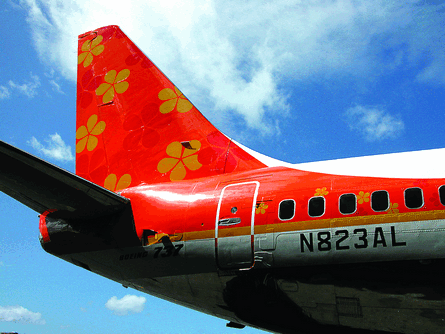Hawaiian Airlines plans to take advantage of the demise of rival Aloha Airlines
Hawaii's airline market lost one of its long-time players when Aloha Airlines ceased operations in early April, and the Islands' largest local carrier, Hawaiian Airlines, is moving to seize the opportunity.
The sudden demise of Aloha "has changed aviation in Hawaii profoundly", says Hawaiian chief executive Mark Dunkerley.
Hawaiian is seeking take up the slack on local routes that are underserved following Aloha's exit. But Dunkerley says the Honolulu-based carrier will not seek to replace Aloha seat for seat, nor will it attempt to replace much of the capacity lost between Hawaii and the mainland US west coast as a result of the sudden shutdown of Aloha and ATA Airlines.
 |
|---|
ATA also ceased operations in early April. It was mainly a charter carrier but had scheduled widebody services to Hawaii from four mainland cities. Aloha operated Boeing 737s between Hawaii and six West Coast destinations as well as on intra-island routes. Together ATA and Aloha counted for 14% of the US mainland-Hawaii market, compared to 21% for Hawaiian (see chart).
Hawaiian flies among the islands and to nine West Coast airports. Shortly after the Aloha and ATA shutdown it unveiled plans to add non-stops to Oakland, California in May. Alaska Airlines also unveiled plans to start service to Maui from its Seattle and Anchorage hubs.
Aloha chief executive Dave Banmiller blamed the carrier's demise squarely on "irrational, below-cost" pricing by inter-island newcomer go!, part of the Mesa Air Group. Banmiller says Aloha needed a $50 average fare to break even at a 62% break-even load factor, while Hawaiian needed $55 a seat and go!, with its 50-seat jets, needed $67 a ticket.
Go! incurred a $14 million operating loss for the year ending 30 September 2007 on a revenue stream of only $26 million (see page 53). It carried 700,000 passengers last year with an average load factor of 67%. As of January go! had a 7% share of the inter-island market, compared to 36% for Aloha and 50% for Hawaiian.
In October, Hawaiian won an $87 million unfair competition lawsuit against Mesa. But Mesa has consistently denied any wrongdoing.
Banmiller says he asked the US Department of Transportation and the Department of Justice "to look into Mesa's predatory pricing practices in Hawaii, and do something about it. We spoke to various lawmakers on [Capitol] Hill. Everyone told me that predatory pricing is hard to prove. I believe that if there is a text book definition of predatory pricing, this is it," says Banmiller.
Assistant Transportation Secretary Mike Reynolds says that the facts in Hawaii do not present a clear-cut case. Even a sympathetic legislator could do little. Senator Daniel Inouye says the situation makes him wonder about re-regulation.
State aid is a more likely possibility, says Representative Mazie Hirono. But Hirono and Inouye acknowledge any such aid will likely be too late for Aloha.
Dunkerley adds the Aloha experience - the carrier's inability to react to rapidly changing market conditions - has some value in providing a reality lesson to airline employees. "I think it's been sobering for all of us," he says. "The realisation that bad things can happen if you don't adapt and move in the right direction is chilling. But with fuel prices continuing their rise, in some ways nothing has changed."
Source: Airline Business























